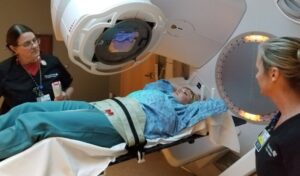Radiation for Lung Metastases
 Radiation therapy is an important approach in multidisciplinary care for the treatment of metastatic lung tumors.
Radiation therapy is an important approach in multidisciplinary care for the treatment of metastatic lung tumors.
External Beam Radiation
External beam radiation therapy is the type of radiation that many people are familiar with. With external beam radiation, high doses of radiation are delivered to a region of the body over a period of time. While there are variations, a typical example would be daily sessions five days per week for five weeks.
The area of a tumor is mapped using CT scan, MRI, PET scan or PET-CT (integrating both PET and CT). The radiation is directed from outside of the body toward that region.
There are several different types of external beam radiation, including:
- Conventional (2D) radiation therapy is traditional radiation therapy and is not used often with lung tumors at this time.
- Conformal therapy (3D) radiation therapy is more specific in that it uses computers to direct radiation toward a tumor from three dimensions. This allows more precise delivery of higher-dose radiation to an area, with less damage to healthy tissue.
- Intensity modulated radiation therapy (IMRT) is similar to conformal therapy but is even more precise and, therefore, spares healthy tissue. The tumor is mapped from many angles to create a shape, and then higher doses of radiation are applied to the tumor, with lower doses going to nearby healthy tissue. This technique may be used when a tumor is near an important structure, such as the heart.
- SBRT for Lung Metastases – CyberKnife® Robotic Radiosurgery painlessly delivers precise beams of radiation to tumors and lesions, without requiring incisions, hospitalization, or long recovery time. It can serve as an effective lung cancer treatment and is an especially good option for patients with early stage lung cancer, complex tumors or patients who prefer a non-invasive way to treat their cancer.
- Allows for an immediate return to normal activities
- Constantly corrects for patient/tumor movement throughout treatment, ensuring radiation beams are always locked on tumor during treatment
- Enables clinicians to maximize and conform the dose to the tumor target while limiting radiation exposure to surrounding healthy tissue
- Outpatient procedure, little or no recovery time and minimal side effects
- Reaches tumors from virtually unlimited directions with robotic mobility
- Requires no anesthesia
- Respiratory tracking feature requires no breath-holding or respiratory gating by patient
- Treats patients in 5 or fewer visits, depending on tumor size, volume, and location
Examples of a few variations of the above may include:
- Volumetric modulated arc therapy (VMAT) is a type of IMRT that can be performed more rapidly.
- Image-guided radiation therapy, another type of IMRT, uses imaging to map the site and deliver the treatment precisely.
- Hypofractionated radiation therapy is an alternative to treat very small tumors. A higher dose of radiation is given with each treatment allowing for fewer treatments (and a shorter period to complete treatment).
Proton beam therapy
Proton beam therapy is a type of radiation therapy that uses protons (one of the elementary particles in the atom) propelled at high speed by a cyclotron instead of photons (electromagnetic particles/waves) to damage tissue. It is used in similar situations as external beam radiation is and most often provides similar results.
The main advantage of proton therapy is when a tumor lies near a vital structure in the body as less tissue damage may occur. Traditional radiation travels through a tumor and reaches some tissue beyond the tumor before dying off. In contrast, proton therapy essentially “stops” and releases all the energy on the tumor without passing through to normal tissue.
While proton therapy may be given in somewhat higher doses (due to the lower risk of tissue damage), the outcomes of the two types of treatment are similar. In addition, proton therapy is only found in some regions of the United States, is usually very expensive, and is less likely to be covered by insurance.
External beam radiation (or proton beam therapy) may be given in a number of different situations, including to treat metastatic lung tumor and for symptoms. Radiation therapy may be used to treat a number of symptoms, including pain or spinal cord compression due to bone metastases, , bleeding, narrowing or obstruction of the airways, esophagus, or large vein in the neck (superior vena cava).
Brachytherapy (Internal Radiation Therapy)
Brachytherapy involves directly applying radiation (via pellets or seeds) to a tumor. It can be done during surgery or during a bronchoscopy. This is a procedure in which a tube with a camera is inserted through the nose or mouth and into the airways.
The radiation travels only a short distance from where the pellets are placed and may result in less damage to nearby healthy tissue than conventional radiation therapy.
Brachytherapy may be done as high-dose therapy, in which the pellets are placed for a short time (during the procedure) and then removed.
Or it may be done as low-dose therapy, in which the pellets emit a lower dose of radiation and are left in place for a few days. In some cases, the pellets may be left in place permanently, with the radiation decreasing over time.
Brachytherapy may be tried for a few different situations, including as a primary treatment for tumors that recur in or near the airways (and can be reached during a bronchoscopy).
The decision for dosage and fraction is determined by location, symptoms, tumor size and indication for treatment. The decision will be made carefully with both the radiation oncologist, other members of the treatment team, and the patient.




